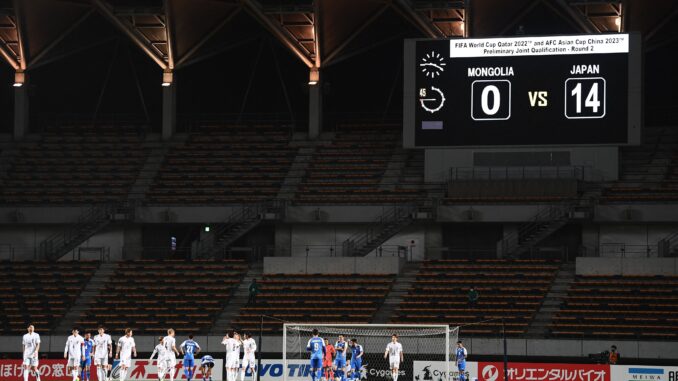
This year’s FIFA World Cup doesn’t start for another three-and-a-half months, and yet discussion over the past week is already looking ahead to the Road to USA-Canada-Mexico in 2026.
After much deliberation, the Asian Football Confederation confirmed the format for the next round of World Cup qualifying, which will be the first for a 48-team World Cup for which Asia has been allocated 8.5 spots.
Earlier this year The Asian Game’s Martin Lowe shared his thoughts on the two proposals on the table, outlining his belief that more opportunity needed to be afforded to Asia’s lowest ranked nations who have often been cut adrift after two preliminary playoff matches; left to wait in the wilderness for the next World Cup cycle to begin.
“The art of balancing inclusion and competitiveness continues to elude the AFC, tending to err on the side of caution in favour of those who bemoan the lack of depth in Asian international football over the last decade,” Lowe wrote in May.
“Over the last few cycles, the AFC has opted to annex those ranked at the lower end of the international rankings to a quick-fire knockout round, effectively spelling an end to the four-year cycle for half of the teams involved, before the so-called elite have even started organising their first training camp.”
With the announcement of the AFC’s chosen model came confirmation that 11 of the 22 lowest ranked nations would be annexed at the first preliminary stage.
It has again raised the question of whether the AFC has the balance right between providing competitive, meaningful matches for the top of the tree – the type of matches that generate interest, attendance and, therefore, money – and giving enough competitive opportunities to those at the other end who need more competitive matches in which to develop.
Speaking on the latest The Asian Game Podcast, our team shared their thoughts on the AFC’s recent announcement.
WORLD CUP IS TOO BIG
Michael Church
We’ve increased Asia’s quota for the World Cup, (and) we’ve doubled it effectively. We’ve gone from four guaranteed spots to eight guaranteed spots.
And yes, I know we’ve got six that the next World Cup, but Qatar as hosts and Australia somehow squeezing through to take that fifth spot as well. But we ordinarily would have four-and-a-half spots, we now have eight-and-a-half spots.
I’m afraid therein lies the issue. A 48 team World Cup is just too big. It just don’t think it works. I don’t think it’s good for the game, and I don’t think it’s a positive move at all. I think what it’s going to do is for the teams that would ordinarily qualify for the World Cup – and we know who the obvious candidates in Asia are, it’s the same teams as they always already Iran, Saudi (Arabia), South Korea, Japan, and for a playoff place Australia.
Those five, you can almost guarantee they’re going to qualify for this next World Cup. So you have to wonder where is the value for them? And for anybody involved in their game in the qualifying process? I mean, you don’t need to make it easier for them, because the likelihood of them finishing outside the top eight is significantly lower anyway, given the strength that they have traditionally.
So I don’t know, I just I don’t think those nations needed a safety net built in. I just think the whole thing is convoluted, and I don’t think it needs to be.
I think the difficulty as well comes along when you try to run Asian Cup qualification at the same time or as part of the World Cup qualification. Again, I understand why that’s been done in the past, I understand even still why it’s being done this time around, but there must be a better way to do it.
THE BALANCE IS RIGHT
Paul Williams
I know there were two scenarios that they (AFC) were considering. There was this one that they’ve gone for, and the other one basically involved all 47 nations starting in one group stage.
That then pleases those who like to give more opportunities to the lower ranked nations because they get more guaranteed matches, but on the flip side of that, you’re going to have more lopsided results, when you have Japan come against the Northern Mariana Islands, for example. What is the value in a matchup like that.
So I can see both sides of this argument, I can see the need to provide more competitive opportunities for the lower ranked nations, I’m not sure having a lot of them cast aside after two matches, and then they get another two to potentially qualify for two Asian Cup qualifying as well, is the way to go.
I know it was floated the idea of potentially bringing back the Solidarity Cup for those nations, and that’s an idea that I could certainly get behind, because that gives them some more guaranteed football. It’s not the sexiest tournament going around, but it’s designed to give those nations some competitive football against nations of similar standing, and it means something to those teams.
Perhaps you could run it that the winner of that tournament then goes into Asian Cup qualifying or something like that.
So when I saw this format come out, this was my preferred option of the two. I think it probably strikes the right balance, (you could) potentially give a couple of extra games to the lower ranked nations if you can somehow force that in, but as someone put to me this week, “World Cup qualifying shouldn’t be about building a structure to prop up your weakest nations.”
World Cup qualifying is about finding the strongest nations in Asia, and I think this is the format that best supports the stronger nations in Asia. As (we’ve said) there’s safety nets everywhere built in, it’s like CONCACAF qualifying that is designed wholeheartedly to get America to qualify every single time with all the safety nets that they’ve got.
It’ll take some miracle for the top four (or) five teams in Asia now to not qualify for a World Cup, (but) my biggest interest in this now, and we can argue the merits of a 48 team World Cup, but it’s going to happen, is who are teams 5-6-7-8 going to be?
We probably know that the top four potentially top five or six, if you assume probably Australia and Qatar get in there again as well, although no guarantees with with Qatar, but who are going to be the other three or four nations that that pop up?
Is it going to be Uzbekistan under Katanec? Is it going to be someone like Iraq? Is a Vietnam or Malaysia or Thailand going to get in there as well? That’s where my fascination now lies because there’s huge opportunity for these nations that they have probably, outside of Uzbekistan, never had before.
Listen to Episode 89 of The Asian Game Podcast



